60 years of Cleveland State and Civil Rights

1964–2024

Protest to Progress is a powerful reflection of the history of Cleveland State University and the Civil Rights movements in Cleveland.
60 years ago , CSU started against the backdrop of the civil rights movement. The gradual addition of Black students finding their way and voice at this nascent university, had a profound and continuing influence on the shaping of CSU as an inclusive campus for all students who seek an urban educational experience .
The exhibit shows CSU’s growth through the rumblings of the social justice movements of the ‘60s and the University’s response to vocal student cries for diversity and inclusion. It highlights the demands on the University resulting in the establishment of a Black Studies program, a Black newspaper, the naming of the first Black homecoming queen and the creation of an African American Cultural Center, all with varying degrees of resistance.
It would be impossible to chronicle all the momentous events of the 1964–2024 era in this Black History Month exhibit. However, Protest to Progress gives a glimpse of how the volatile ‘60s and the first wave of restless Black students helped shape the early beginnings and the future of CSU.
1967–68 | 3
A University is Born Amidst Civic UNREST
In 1964, while Governor James Rhodes’ administration urged the state legislator to green light CSU, the United Freedom Movement (UFM) was leading a major, anti-segregation Black student boycott of the Cleveland schools as a result of the tragic accidental death of the Rev. Bruce Klunder. It was also the year the Civil Rights Act of 1964 was signed into law.
CLEVELAND PUBLIC SCHOOLS
While the 1964 creation of CSU was big news, another headline grabber was the boycott of the Cleveland Public Schools, led by the United Freedom Movement (UFM). Railing against segregated schools, 85% of the school district’s 60,000 Black students supported a mass walkout precipitating the organizing of 100 Freedom Schools in community centers and churches scattered across the city’s east side.
REV. BRUCE W. KLUNDER
On April 7, the Rev. Bruce W. Klunder tragically loses his life as he lay behind a bulldozer that backed up to avoid a group of demonstrators in front of the vehicle. Rev. Klunder and others were protesting the construction of Stephen E. Howe Elementary School on Lakeview Avenue, seen as yet another school reinforcing a pattern of segregation in Cleveland’s Black east side community.
MALCOLM X

Often considered a polarizing figure, Malcom X delivers his searing “The Ballot or the Bullet” speech in the sanctuary of Cory United Methodist Church on East 105th Street on April 3.
Civil Rights Act of 1964
is signed into law, outlawing discrimination based on race, color, religion, sex and national origin.
CSU IS BORN
December 18: Gov. James A. Rhodes signs the Ohio Assembly’s Amendment HB 2 creating Cleveland State University (CSU). After signing the House Bill into law, Rhodes quickly appoints nine men to the CSU Board of Trustees. They hold their first meeting on December 22.
1964
4 | 1964
Issue
of Call and Post from April 25, 1964
HOPE, TRAGEDY AND REDEMPTION
1965 was a year fraught with racial tension both in Cleveland and across the nation starting with the assassination of Malcolm X on February 21.

Selma, Alabama
In response to the fatal shooting of activist Jimmie Lee Jackson, a Baptist deacon, in Marion, Alabama, Dr. Martin Luther King Jr. leads an historic three-day March from Selma to Montgomery in an effort to register Black voters in the South. They were confronted with deadly violence along the way, but finally achieved their goal. The march raised awareness of the difficulties faced by Black voters and the need for a national Voting Rights Act.
On March 15, President Lyndon B. Johnson pledges his support to the Selma protesters and urged lawmakers to pass the landmark Voting Rights Act of 1965, the year CSU officially opens its doors.
CLEVELAND STATE UNIVERSITY
Amidst the national racial tension, locally a wave of enthusiasm ushered in a fully incorporated Cleveland State University.
March 10: Fenn College is incorporated as the nucleus of CSU, including its buildings, faculty, staff and 2,500 students.


September 1: the official end of Fenn College and the beginning of a fully incorporated CSU with Dr. Harold Enarson as its first president.
The University welcomes its first class of undergraduates on September 28.
State Representative Carl Stokes (a Cleveland-Marshall College of Law alumnus) is grand marshal of the parade for CSU’s first Homecoming on November 6.
Closeup of Edmund Pettus Bridge in Selma, Alabama. [Source: Adobe Stock]
Looking east toward Fenn Tower, 1983 Euclid Ave., on the northeast corner of East 24th St. and Euclid Ave. [Source: The Cleveland Memory Project]
Carl Stokes at the first Cleveland State University Homecoming, 1965. [Source: Cleveland State University Archives]
Fenn College seal
1965 1965 | 5
The BLOW UP
U.S. CIVIL RIGHTS COMMISSION HEARINGS
In April, the U.S. Commission on Civil Rights holds hearings in Cleveland, gathering evidence about employment discrimination, police brutality, poor housing, ongoing school segregation and racism among the community. The hearings are televised locally, lending tension to a community already in unrest.

THE HOUGH RIOTS (JULY 18–24)
The deadly Hough Riots in Cleveland broke out on the sweltering summer evening of July 18 when the white bar owner of the Seventy-Niners Café, at the corner of Hough Avenue and East 70th Street denied a Black customer a takeout glass of water. Some argue the incendiary six-day outburst that resulted in looting, vandalism, arson and death was almost inevitable given Hough’s substandard, overcrowded housing, alleged police harassment and price gouging by area merchants. Cleveland Mayor Ralph Locher calls in the National Guard to restore order.
CSU HOLDS STRONG
On February 1, Dr. Harold Enarson is selected as CSU’s first president (1966−72). Amidst the turmoil surrounding the University on city streets, Dr. Enarson launches numerous initiatives and grows the campus during his tenure:
• Unveiling of the first CSU Master Plan in April
• Groundbreaking in November for the Science building, the first new addition to campus
• Enrollment increases from 5,000 to 15,000 students
• Faculty increases from 90 to 450
• Campus expansion from nine acres and three buildings to 27 acres with four new classroom and office buildings
 Broom brigade on Hough Avenue, 1966. [Source: Cleveland Memory Project]
The original campus master plan was developed by Outcalt, Guenther, Rode & Bonebreak and approved by the CSU Board on Trustees in 1966.
[Source: Cleveland Memory Project]
Broom brigade on Hough Avenue, 1966. [Source: Cleveland Memory Project]
The original campus master plan was developed by Outcalt, Guenther, Rode & Bonebreak and approved by the CSU Board on Trustees in 1966.
[Source: Cleveland Memory Project]
6 | 1966
On June 12, CSU holds its first commencement.
Succeeding administrations were responsible for adding significant research and public service programs including CSU’s World Trade Center, Advanced Manufacturing Center, Speech and Hearing Clinic, Center for Neighborhood Development, Legal Clinic and Center for Applied Research in Education, among other progressive innovations.


john m C lendon
CSU hires John McLendon as their new head basketball coach (1966−69), making history in collegiate athletics as the first Black basketball coach at a predominantly white university. McLendon was previously the first Black head coach of a pro basketball team.
John McLendon, left, coached basketball at CSU from 1966 to 1969. At right is James Rodriguez, assistant basketball coach. [Source: Cleveland State University Archives]
1966 | 7
First commencement the Cleveland Masonic Auditorium, 1966. [Source: Cleveland Memory Project]
Apr. 26
Nov. 7
Dr. King visits Cleveland to drum up votes for Carl B. Stokes’ historic mayoral race with Seth Taft. During Dr. King’s visit, he stops at Glenville High School and delivers what is now known as “King’s Speech.” In his remarks, Dr. King delivers this telling phrase: “If we are going to achieve freedom, we’ve got to engage in action programs to make that freedom possible.”

Scan the qr-code to listen to the King’s Speech:
Students express mixed opinions about the new, temporary Quonset hut classroom building. Master’s degrees in science, biology, economics, and science and physics are established.


That same day, history is made in Cleveland and the country as Carl B. Stokes defeats Seth Taft to become the first Black mayor of a major American city.
Nov. 15
Carl B. Stokes makes mayoral history and launches ambitious $1.5 billion urban Marshall Plan called Cleveland Now. The program collapses when summer youth program funds given to Black Nationalists are traced to weapons and ammunition used in the Glenville Shootout (July 23–24, 1968).
Sherida Freeman (née Foster), then a senior at Glenville High School, shakes hands with Martin Luther King Jr. before his speech. “It was wild,” she says of meeting Dr. King over 50 years ago. [Source: The Cleveland Public Library]
Looking northwest from Fenn Tower toward the Quonset Hut classrooms. Stilwell Hall can be seen across East 24th St., 1960 [Source: Cleveland Memory Project]
Mayor Carl Stokes greets marchers in the “Poor Peoples March,” 1968 [Source: Cleveland Memory Project]
1967–68
8 | 1967–68
1967 bit.ly/3HxVPa4
Feb. 8
Ten anti-Vietnam War protesters are heckled and pelted with water balloons and other objects by a crowd of approximately 100 counter-protesters in front of Fenn Tower.
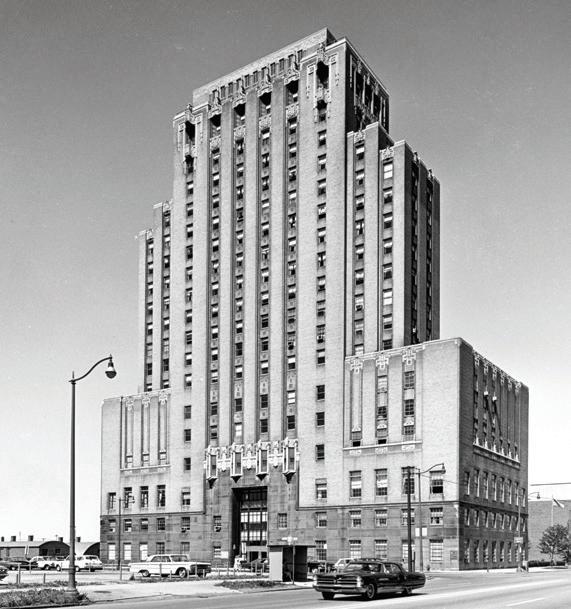
Apr. 4
Civil Rights leader and Baptist minister Dr. Martin Luther King Jr. is assassinated in Memphis, Tennessee, igniting riots in Cleveland and across the country.


Apr. 1 1
President Lyndon B. Johnson signs into law the Civil Rights Act of 1968.
July 23
The Glenville Shootout, a fierce hourlong gun battle in Cleveland’s east side neighborhood of Glenville, costs seven people their lives, including three Cleveland police officers. Rioting ensues for three days following, fueled by racism, resulting in the damage or destruction of more than 60 neighborhood buildings.
Nov. 6
Louis Stokes, brother of Mayor Carl Stokes, is elected as Ohio’s first Black congress person from Cleveland’s 21 st district. He would serve for 30 years.
 Looking northwest from Fenn Tower toward the Quonset Hut classrooms. Stilwell Hall can be seen across East 24th St., 1960 [Source: Cleveland Memory Project]
Left: Crowd gathered on Public Square outside of the Old Stone Church for the memorial service for Dr. Martin Luther King, Jr., 1968 [Source: Cleveland Memory Project]
Right: Front page of Cleveland’s The Plain Dealer on Friday, April 5, 1968.
Louis Stokes, 1976 [Source: Cleveland Memory Project]
Looking northwest from Fenn Tower toward the Quonset Hut classrooms. Stilwell Hall can be seen across East 24th St., 1960 [Source: Cleveland Memory Project]
Left: Crowd gathered on Public Square outside of the Old Stone Church for the memorial service for Dr. Martin Luther King, Jr., 1968 [Source: Cleveland Memory Project]
Right: Front page of Cleveland’s The Plain Dealer on Friday, April 5, 1968.
Louis Stokes, 1976 [Source: Cleveland Memory Project]
1968
1967–68 | 9
LOCAL PROTEST BEGINS TO LEAD TO PROGRESS
Cleveland’s inner city residents’ most significant obstacles remained economic in nature. Good-paying, industrial jobs declined or shifted to the suburbs undercutting funding for public schools. This made it difficult for black children to obtain the necessary skills.
Around Cleveland, the Black movement gains strength.
• The Afro Set Nationalist Party, based in the Hough neighborhood, comes to fruition and is primarily responsible for the rise of Black Nationalist sentiment in Cleveland.
• Annette Ogletree, a Cleveland Public School teacher, becomes the center of student protests for teaching Black Nationalism.
• The Black Panther Party establishes a local chapter.
• More riots ensue at Collinwood high school.
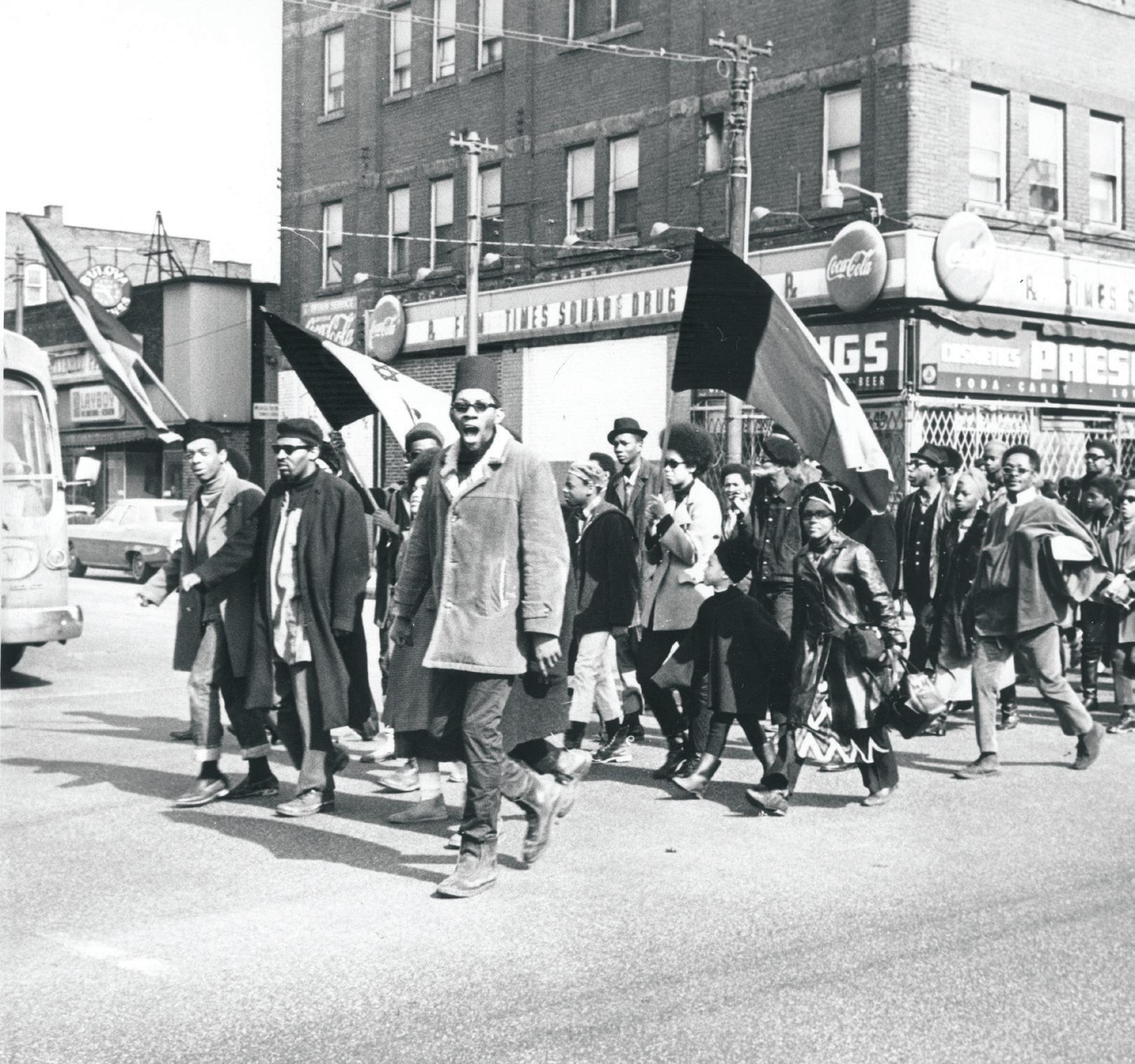 The Black Nationalists marching at 105 Superior Avenue in Cleveland, Ohio, 1969. [Source: Cleveland Memory Project]
The Black Nationalists marching at 105 Superior Avenue in Cleveland, Ohio, 1969. [Source: Cleveland Memory Project]
10 | 1969–70

CSU SEES SIGNIFICANT PROGRESS
As a result of civil unrest throughout the nation and Cleveland, sweeping changes took place at CSU spurred by demands the Society of African American Unity (SAAU) presented to President Enarson. Cleveland State was seeing progress from protest:
• Barbara Brown is named CSU’s first Black Homecoming Queen in November 1968. An unflattering Cauldron photo of Brown prompts a group of students to burn the issue of the newspaper on campus grounds.
• The Black Studies Program launches in June 1969 under Dr. Ralph Pruitt’s leadership. Its creation followed significant activism by Black and white students on campus to enhance representation for minorities in all aspects of University life.
• Multi-cultural student publication The Vindicator is founded.
• The Afro-American Cultural Center opens in Mather Mansion.
• Fenn Tower opens its doors to the first female residents on campus.
• Enrollment grows to 11,100 students and the number of faculty nearly triples from 145 to 406 by Fall 1970.
• The erstwhile Cleveland-Marshall College of Law becomes part of CSU. It is renamed Cleveland State University College of Law in 2022.
 Congressman Louis Stokes (seated on left) and Cleveland Mayor Carl Stokes (center), joined President Enarson outside Mather Mansion on October 28, 1970, at the dedication ceremonies for the African-American Cultural Center. [Source: Cleveland Memory Project]
Congressman Louis Stokes (seated on left) and Cleveland Mayor Carl Stokes (center), joined President Enarson outside Mather Mansion on October 28, 1970, at the dedication ceremonies for the African-American Cultural Center. [Source: Cleveland Memory Project]
1969–70 | 11
Ralph Pruitt, first Director of the Black Studies Program at Cleveland State University, 1969. [Source: Cleveland Memory Project]
VOICES
Annie Easley
(BA, Mathematics 1978)
NASA Mathematician
Annie Easley was one of four African Americans on a staff of 2,500 “human computers” at the NASA Lewis Research Center when it was NACA. She enrolled at Cleveland State to study mathematics and complete the degree that had eluded her for more than 20 years. “I did much more than I thought I could ever do working full time and going to class at CSU. I’m glad I did it. You’re never too old if you want to go back to school.” She retired in 1989.


Frank Jackson
(BA History 1977, MS Urban Studies 1979, JD 1983)
Former Mayor of Cleveland
Former Cleveland City Councilman and Assistant City Prosecutor
Frank Jackson’s administration has been characterized as stability amid difficult economic times. After serving in the army during the Vietnam War, he earned an associate degree from Cuyahoga Community College and three degrees from Cleveland State University. He became an assistant city prosecutor, then Cleveland city councilperson, then city council president. In November 2005, he was elected mayor over incumbent Jane Campbell.
Mayor Jackson faced one of the worst economic climates in Cleveland’s history. In 2010, he began a number of building projects, opened the bus-rapid transit HealthLine and helped to pass a $15 million public school levy.
Mayor Jackson is the only mayor in Cleveland’s history to serve four terms making him Cleveland’s longest-serving mayor.
12 | VOICES
Dr. Regennia Williams
(BA 1986, MPA 1990, BA Liberal Studies 2012)
Retired Cleveland State University Professor
Dr. Regennia Williams is a three-time CSU graduate and former associate professor of history. “My older sister and future husband were enrolled at CSU and both loved it. I came to CSU based on its reputation and affordability.”
During her time at CSU, she was a member of the University Chorus, the Minority Artist Residency program, Delta Sigma Theta sorority and other organizations.
Dr. Williams joined the CSU faculty in 1992, received a Fulbright Fellowship in 2010 and during her tenure was a prolific researcher, author and lecturer, especially in the area of Cleveland’s African American history. She is the founder of the Initiative for the Study of Religion and Spirituality in the History of Africa and Diaspora, a non-profit education corporation. She authored Cleveland State University: 50 Years. She is also a member of the Oral History Association, the Western Reserve Historical Society and the National Museum of African American History and Culture. Dr. Williams is now an independent scholar and consultant.


Dwayne Bray
(BA, Communications 1988)
ESPN Vice President
Production and Senior Writer for Andscape Peabody Murrow and DuPont Awardee
While at CSU, Bray was a finalist for the nation’s best young journalist in 1988, The Livingston Award and editor of The Cauldron. “I learned to report and write at Cleveland State. Writing is the most valuable skill I have. If you can write, you can articulate. If you can articulate, you can capture a person’s or an audience’s attention.”
VOICES | 13
The 1970s
Throughout the 1970s, Cleveland State University kept growing under the leadership of its second president, Dr. Walter Waetjen (appointed November 9, 1972):
• February 21, 1973: CSU Board of Trustees formally adopts the Affirmative Action Policy Statement and Plan.
• October 20, 1973: Physical Education Building opens.
• October 18, 1974: University Center opens.
• October 1974: New home for the Cleveland-Marshall College of Law opens.
• April 20, 1977: Maxine Goodman Levin College of Urban Affairs opens.
And numerous local events took place throughout the city, showing progress all around.
May
Muhammad Ali addresses the students at Glenville High School on the last day of their Third Annual week-long Eusi Sikukuu (Black Festival).

Scan the qr-code to listen to Ali’s speech: bit.ly/4b73XM9
1971
25 14 | THE 1970S
Nov. 8
Political activist Angela Davis speaks at the Allen Theatre as part of CSU’s Assembly and Lecture Series.

Apr. 8
Frank Robinson becomes MLB’s first Black manager as the Cleveland Indians’ player/manager.
Aug. 31
A landmark federal court ruling prompts U.S. District Judge Frank Battisti to rule that Cleveland’s city schools must be desegregated.
Slowed by litigation and disputes, the district began decades of crosstown busing to offset residential segregation patterns.
 After homering in his first at-bat on Opening Day 1975, Cleveland Indians player/ manager Frank Robinson is greeted by Tribe player John Lowenstein, 1975.
[Source: Cleveland Memory Project]
After homering in his first at-bat on Opening Day 1975, Cleveland Indians player/ manager Frank Robinson is greeted by Tribe player John Lowenstein, 1975.
[Source: Cleveland Memory Project]
1972
Angela Davis speaks at the Allen Theater, 1972. [Source: Cleveland State University Archives]
1975
THE 1970S | 15
The 1980s
The ’80’s saw both growth and civic regression, as activists continued their quests.
By 1988, the Cleveland School District was “the only majority black, large city system in the country which was totally desegregated,” according to Dr. Gordon Foster, expert witness in the original 1976 case.
CSU was visited twice in the 1980s by Coretta Scott King, widow of the Rev. Dr. Martin Luther King Jr.: in April 1980 to speak as part of CSU’s Black Aspirations Week and again in June 1985 to receive an honorary doctorate degree during commencement.
1982
Over the course of several months in 1982, the Rev. Horace Rickerson, Brian Warford (17-year old CSU student) and Timothy Sheehan (CSU staff) are shot and killed by a self-proclaimed modern-day Nazi serial killer. Rickerson and Warford were Black.
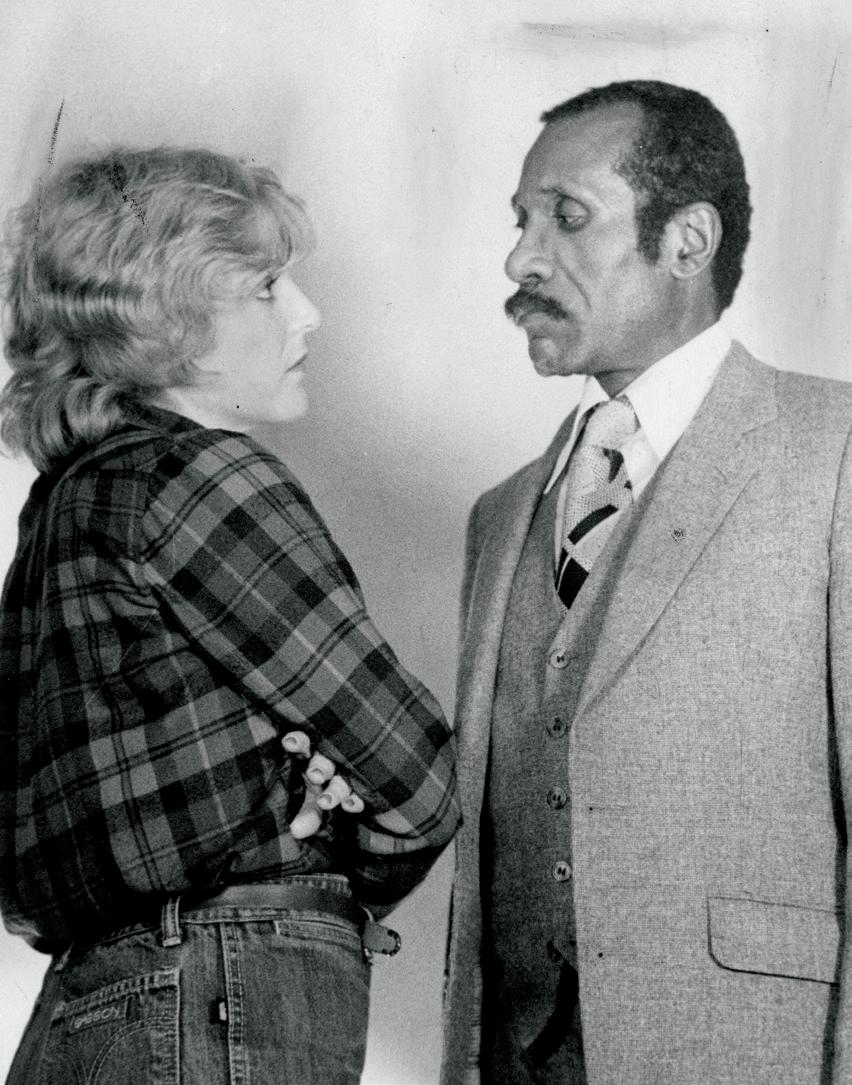
1983
Albert Cornelius Antoine, an African American chemist, professor and minority activist joins CSU after a career at NASA and other government research agencies.
 Rev. Horace Rickerson performing in East Cleveland Community Theater, 1982 [Source: Cleveland Memory Project]
Rev. Horace Rickerson performing in East Cleveland Community Theater, 1982 [Source: Cleveland Memory Project]
16 | THE 1980S
Albert C. Antoine at NASA Glenn Research Center, 1981. [Source: NASA]
In March, Cleveland City Council President George Forbes accuses CSU of being a racist institution. The University responds with a special committee to investigate racial issues in partnership with the Greater Cleveland Roundtable.
In October, after a federal investigation, CSU agrees to settle U.S. Department of Labor charges that CSU may have underpaid women and Black faculty and staff, and discriminated against Black job applicants.
At the end of the year, the CSU Civic Committee on Race Relations releases a report making numerous recommendations including the establishment of a Committee on Minority Affairs. The CSU Board of Trustees immediately adopts the recommendations.
CSU’s Black Alumni Association establishes the Curtis Wilson Alumni Scholarship Fund, named for Dr. Curtis Wilson.
In December 1988, CSU President Dr. John Flower outlines plans to hire a minority affairs officer and to step up recruiting and retention efforts for minority employees and students. In his report to the Board of Trustees he says, “Cleveland State University is one of the most valuable assets held by the citizens of Greater Cleveland… All citizens, regardless of race, gender, religion must share in this brighter future.”

1987 THE 1980S | 17
Dr. Curtis Wilson, Director of the Black Studies Program for 18 years from 1971−1989. [Source: Cleveland State University Archives]
The 1990s
There was still much work to be done in the ’90’s, but the momentum continued to swing forward toward progress.
Nov. 8
CSU celebrates its 25 th Anniversary with “A Splash of Silver” gala. 100 protesters outside the gala came to support the first vice president for minority affairs, Dr. Raymond Winbush, who left the University in June 1990 over a salary dispute. Dr. Winbush was the only CSU VP not offered a merit raise. He sought to negotiate and his contract was withdrawn. This prompts student sit-ins, demonstrations and reopened old wounds. The Faculty Senate weighs in with a resolution decrying ongoing problems with racism on campus.
CSU President John Flower speaks to the City Club of Cleveland saying that access to higher education for minority students is not only a problem at CSU, but nationwide. “CSU is a new breed of university. We cannot afford to be an Ivory Tower,” he says.
 Dr. John Flower, CSU’s third president. [Source: Cleveland Memory Project]
Dr. John Flower, CSU’s third president. [Source: Cleveland Memory Project]
18 | THE 1990S
Apr. 8
Dr. Njeri Nuru Holm is hired as vice president of minority affairs and community relations. She creates several programs to enhance diversity and inclusion including the AHANA initiative, targeting African American, Hispanic, Asian and Native American (AHANA) students.
Aug. 15
Mar. 8
Black Gay Pride becomes an official annual celebration of Pride among Black Clevelanders. Annual Pride events for Black members of the LGBTQ community aim to make Black LGBTQ people more visible and to advocate for support, services, awareness and inclusion.

Cleveland Black Pride is incorporated and applies for nonprofit status. In this same year, U.S. District Chief Judge George W. White concludes that it is time to end the quarter-century court battle over integrating the Cleveland City Schools.
The Cleveland Gay Pride March, showing a car that was sponsored or entered-in by The Gay 90’s with Buck Harris. The car is a white, or lightly colored, convertible sedan. The driver has a fist raised, while a sign showing The Gay 90’s’ time slot, AM frequency, and one of their slogans (“An Out of Closet Experience”) is held up behind him by others riding in the back seat, 1996 [Source: Cleveland Memory Project]
THE 1990S | 19
The 2000s
As we enter a new century, the forward momentum is palpable at CSU and around Cleveland, even despite serious socioeconomic issues.
CSU establishes numerous partnerships with other local educational institutions to create articulation agreements for seamless transfer and ease for students.
And new initiatives continue to take shape, including the beginning of the Women’s Studies program, collaborations with CMSD and the opening of the Pratt Center.
The Afro-American Cultural Center is renamed the Howard A. Mims African American Cultural Center.
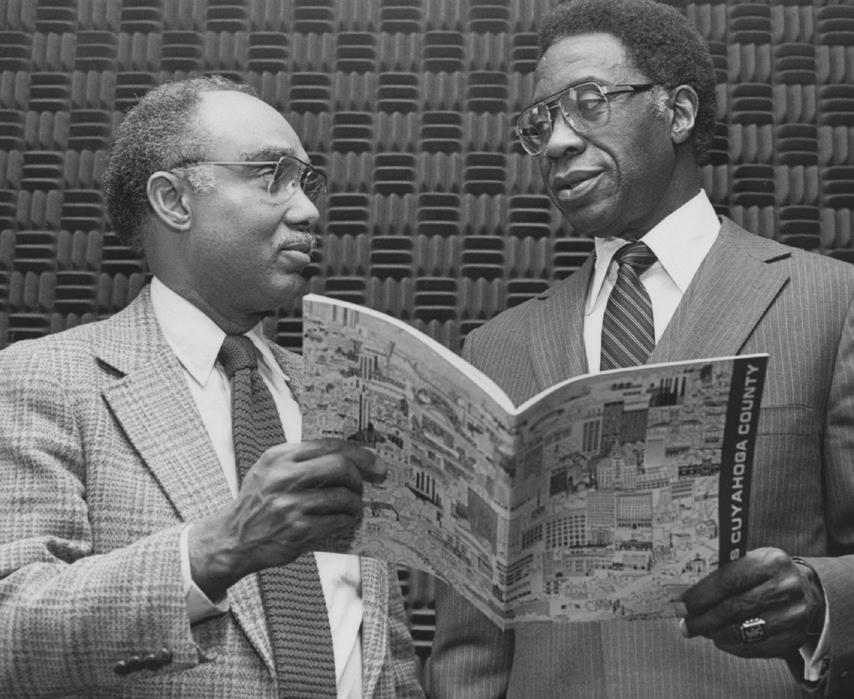
CSU hosts an historic presidential debate between candidates Hillary Clinton and Barack Obama.
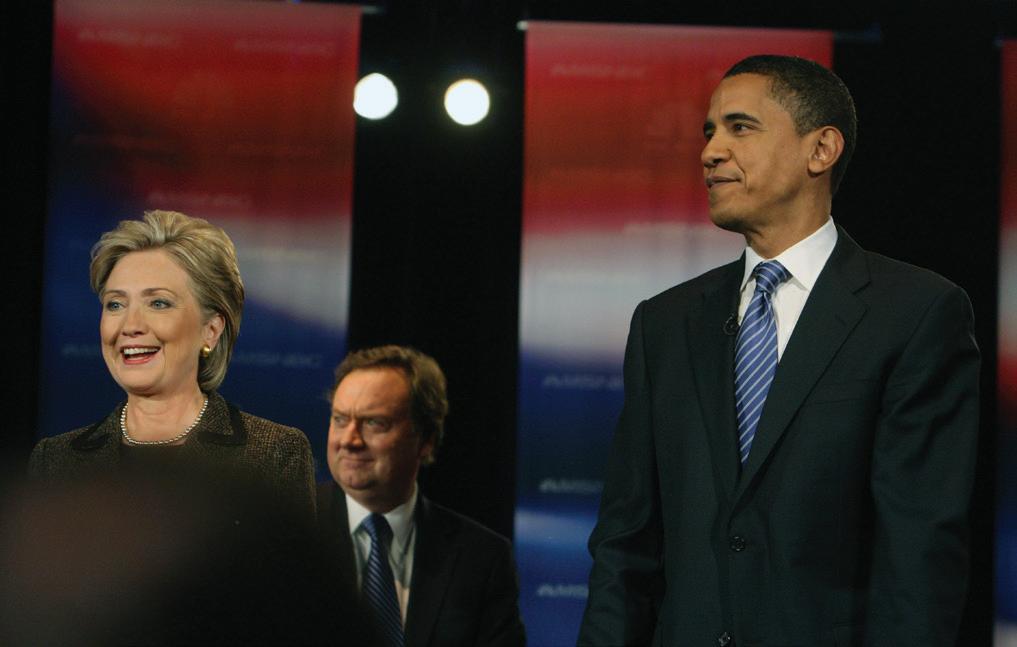
The Affirmative Action Office name is changed to the Office of Institutional Equity, appointing Dr. Charleyse S. Pratt as assistant vice president.
 Democratic presidential candidate debate at Wolstein Center. Hillary Clinton and Barack Obama with co-moderator Tim Russert of NBC News, a CSU College of Law alumnus, 2008. [Source: CSU Marketing Photo Archives]
Virgil Brown and Howard Mims [Source: Cleveland Public Library]
Democratic presidential candidate debate at Wolstein Center. Hillary Clinton and Barack Obama with co-moderator Tim Russert of NBC News, a CSU College of Law alumnus, 2008. [Source: CSU Marketing Photo Archives]
Virgil Brown and Howard Mims [Source: Cleveland Public Library]
26 2 013 Aug. 19 20 | THE 2000S
Dr. Charleyse S. Pratt [Source: CSU Marketing Photo Archives]
Feb.
2 014 2017 Feb. 16
In September, CSU earns the Higher Education Excellence in Diversity (HEED) Award, recognizing CSU as a university that demonstrates an outstanding commitment to diversity and inclusion.
The Sullivan/Deckard Opportunity Scholarship program, which guides youth who age out of the foster care system through the college application process, is established. The program officially launches in June 2015.
2 015 jan. 15
Robert P. Madison, the first African American to earn an architectural degree in Ohio who was responsible for the design of CSU’s Science and Research Center, is honored by the Maxine Goodman College of Urban Affairs with the In Tribute to Public Service Award.
One year after the murder of 12-year-old Tamir Rice, Black Lives Matter Cleveland is established. Activists from across the nation come to Cleveland for the National Convening of the Movement for Black Lives at Cleveland State.
Barbara and Frank Sullivan gift CSU $1 million to create The Pratt Center to honor the work of Dr. Charleyse Pratt.
 Dr. Charleyse Pratt (seated) with her husband Suffragan Bishop Gregory A. Pratt (standing, left) and son Jarrett Pratt (standing, right). [Source: CSU Marketing Photo Archives]
Dr. Charleyse Pratt (seated) with her husband Suffragan Bishop Gregory A. Pratt (standing, left) and son Jarrett Pratt (standing, right). [Source: CSU Marketing Photo Archives]
THE 2000S | 21
Common Black Lives Matter design since 2013. [Source: Adobe Stock]
Our Progress
2020–Today
2 020 May 25
George Floyd is murdered by police in Minneapolis, MN. resulting in nation-wide demonstrations and protests against police brutality.

2 021 Mar. 26
June 17 aug. 26
CSU President Harlan Sands presents CSU 2.0— a new vision for the University as it emerges from the global pandemic.
Juneteenth becomes a federal holiday, celebrated annually on June 19.
Dr. Phillip “Flapp” Cockrell is hired as CSU’s Vice President for Campus Engagement, Diversity, Equity and Inclusion to help advance educational access and affordability in Northeast Ohio and beyond.
 CSU 2.0 logo, 2021
Peaceful protests taking place outside of Cuyahoga County Court House in Cleveland on May 30, 2020.
Dr. Phillip “Flapp” Cockrell, 2021 [Source: Cleveland State University]
CSU 2.0 logo, 2021
Peaceful protests taking place outside of Cuyahoga County Court House in Cleveland on May 30, 2020.
Dr. Phillip “Flapp” Cockrell, 2021 [Source: Cleveland State University]
22 | OUR PROGRESS CONTINUES
Aug. 19
2 023
Continues
Sept. 1
The Black Studies Program established in 1969 is renamed the Department of Africana Studies. Its focus is on the African American experience, promoting greater awareness of the African diaspora.
CSU launches the new Division of Student Belonging and Success, under the direction of Dr. Tachelle Banks. The new division includes:
• Campus Engagement
• Inclusion and Multicultural Engagement
• LGBTQ+ Student Services
• Lift Up Vikes! Resource Center and Food Pantry
• LINK Program
• The MareyJoyce Green Women’s Center
• The Pratt Center
• TRIO/SSS
Currently, the University boasts nearly 20 Black/Multicultural student and staff organizations:
• African Student Association
• Africana Studies Sankofa Society
• Alpha Kappa Alpha Sorority Inc.
• Alpha Phi Alpha Fraternity Inc.
• Association of Black Social Workers
• Black Faculty and Staff Organization
• Black Law Students Association
• Black Leading Arts Cultural Club
• Black Scholars in Psychology
• Delta Sigma Theta Sorority Inc.
• Minority Association of Pre-Medical Students
• Multicultural Association of Nursing Students
• National Society of Black Engineers
• Omega Psi Phi Fraternity, Inc.
• Phi Beta Sigma Fraternity Inc.
• Sigma Gamma Rho Sorority Inc.
• Zeta Phi Beta Sorority Inc.
• The Vindicator student publication
OUR PROGRESS CONTINUES | 23
“Here at CSU, we are committed to creating a climate that acknowledges, respects and values all aspects of diversity in our community. To that end, inclusive excellence and engaged learning among diverse groups of students, staff and faculty are guiding principles for everything we do. This commitment continues.”

Dr. Laura Bloomberg
Cleveland State University’s 8 th President
“CSU is the only institution of higher learning in Cleveland that offers a major in Africana Studies and has a formal academic department. Supporting CSU’s mission, the department’s faculty provide a myriad of students an opportunity to experience a diverse educational setting to broaden their understanding of the human experience.
Under my tenure, the Department of Africana Studies has more than doubled its majors and minors, expanded its course offerings, secured courtesy faculty appointments and established new connections in the community. While all of these are great achievements, there is still much more to be done.”
Dr. Thomas Bynum Chair, Africana Studies Department
Learn more about Africana Studies at CSU: csuohio.us/ Africana-Studies

24 | OUR PROGRESS CONTINUES
Green Book Cleveland is a restorative history project of the Center for Public History and Digital Humanities at Cleveland State University and the Cuyahoga Valley National Park. With help from our collaborators and community members, we are passionate about preserving stories of Black leisure and entertainment in Northeast Ohio.
Based on Victor H. Green’s Green Book guides, published between 1936 and 1966 to help Black motorists find courteous service and avoid harassment or rejection in their travels, and countless other news items, recent books, etc. Green Book Cleveland seeks to document Black economic life, from restaurants, taverns and nightclubs to beauty and barber shops, and even the garages and service stations that facilitated travel within and beyond Black neighborhoods and the stories of small business owners and the travelers themselves.
Dr. Mark Souther
Professor and Director of The Center for Public History and Digital Humanities
bit.ly/3HyiJhd OUR PROGRESS CONTINUES | 25
Explore the Green Book Cleveland:
1964–2024
60 years of Cleveland State and Civil Rights
Thank you to:
Dr. Thomas Bynum, Department of Africana Studies
Ron Kisner, Alumnus and Founder of The Vindicator
Prester Pickett, Howard A. Mims African American Cultural Center
CSU Conference Services
CSU Facilities
Michael Schwartz Library Archives and Special Collections
CSU Printing Services
CSU University Marketing
President Laura Bloomberg for her leadership, encouragement and support of this project
26 | ACKNOWLEDGEMENTS
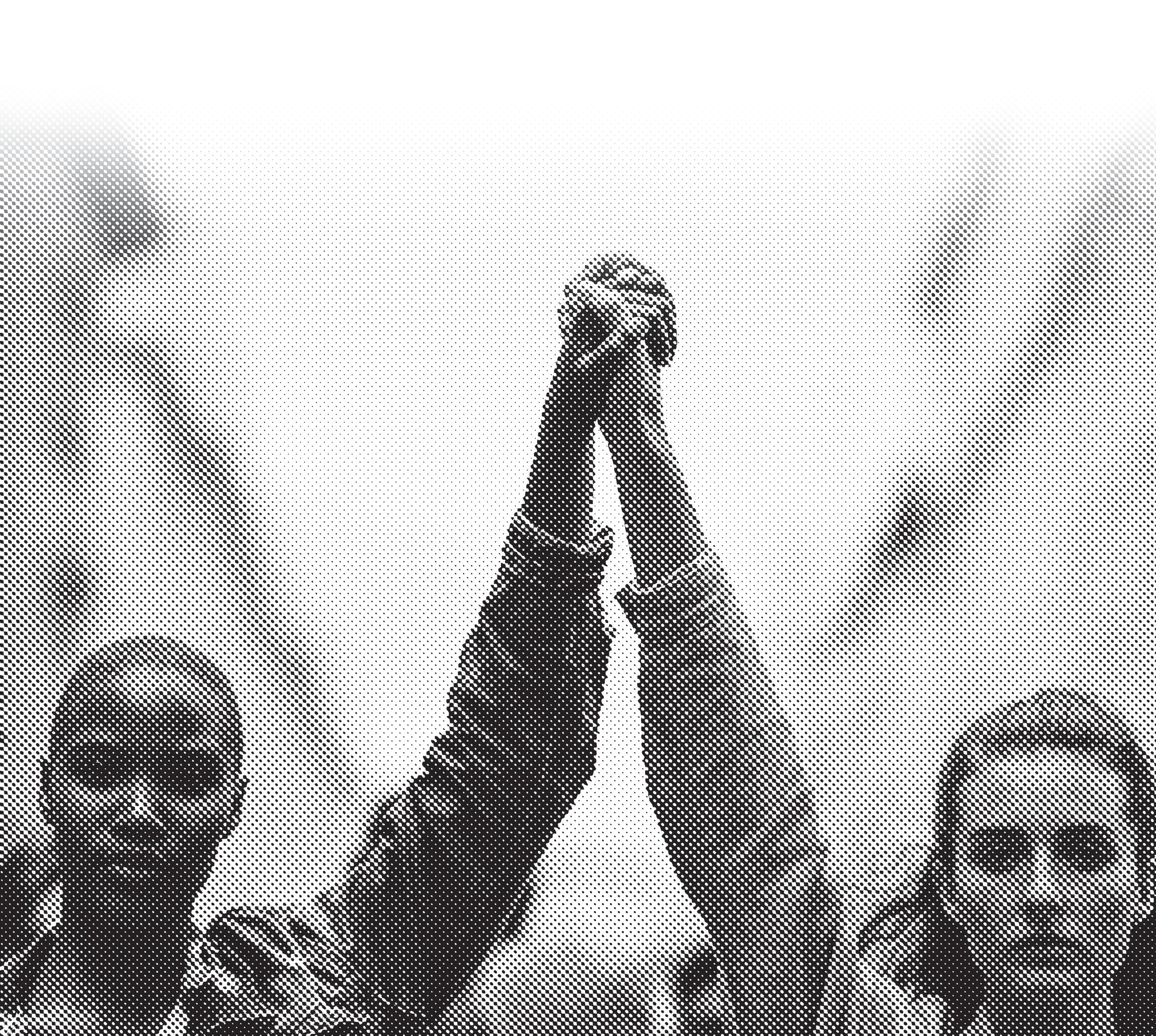
CSU is an AA/EO institution. ©2024 University Marketing 230387








 Broom brigade on Hough Avenue, 1966. [Source: Cleveland Memory Project]
The original campus master plan was developed by Outcalt, Guenther, Rode & Bonebreak and approved by the CSU Board on Trustees in 1966.
[Source: Cleveland Memory Project]
Broom brigade on Hough Avenue, 1966. [Source: Cleveland Memory Project]
The original campus master plan was developed by Outcalt, Guenther, Rode & Bonebreak and approved by the CSU Board on Trustees in 1966.
[Source: Cleveland Memory Project]








 Looking northwest from Fenn Tower toward the Quonset Hut classrooms. Stilwell Hall can be seen across East 24th St., 1960 [Source: Cleveland Memory Project]
Left: Crowd gathered on Public Square outside of the Old Stone Church for the memorial service for Dr. Martin Luther King, Jr., 1968 [Source: Cleveland Memory Project]
Right: Front page of Cleveland’s The Plain Dealer on Friday, April 5, 1968.
Louis Stokes, 1976 [Source: Cleveland Memory Project]
Looking northwest from Fenn Tower toward the Quonset Hut classrooms. Stilwell Hall can be seen across East 24th St., 1960 [Source: Cleveland Memory Project]
Left: Crowd gathered on Public Square outside of the Old Stone Church for the memorial service for Dr. Martin Luther King, Jr., 1968 [Source: Cleveland Memory Project]
Right: Front page of Cleveland’s The Plain Dealer on Friday, April 5, 1968.
Louis Stokes, 1976 [Source: Cleveland Memory Project]
 The Black Nationalists marching at 105 Superior Avenue in Cleveland, Ohio, 1969. [Source: Cleveland Memory Project]
The Black Nationalists marching at 105 Superior Avenue in Cleveland, Ohio, 1969. [Source: Cleveland Memory Project]

 Congressman Louis Stokes (seated on left) and Cleveland Mayor Carl Stokes (center), joined President Enarson outside Mather Mansion on October 28, 1970, at the dedication ceremonies for the African-American Cultural Center. [Source: Cleveland Memory Project]
Congressman Louis Stokes (seated on left) and Cleveland Mayor Carl Stokes (center), joined President Enarson outside Mather Mansion on October 28, 1970, at the dedication ceremonies for the African-American Cultural Center. [Source: Cleveland Memory Project]






 After homering in his first at-bat on Opening Day 1975, Cleveland Indians player/ manager Frank Robinson is greeted by Tribe player John Lowenstein, 1975.
[Source: Cleveland Memory Project]
After homering in his first at-bat on Opening Day 1975, Cleveland Indians player/ manager Frank Robinson is greeted by Tribe player John Lowenstein, 1975.
[Source: Cleveland Memory Project]

 Rev. Horace Rickerson performing in East Cleveland Community Theater, 1982 [Source: Cleveland Memory Project]
Rev. Horace Rickerson performing in East Cleveland Community Theater, 1982 [Source: Cleveland Memory Project]

 Dr. John Flower, CSU’s third president. [Source: Cleveland Memory Project]
Dr. John Flower, CSU’s third president. [Source: Cleveland Memory Project]



 Democratic presidential candidate debate at Wolstein Center. Hillary Clinton and Barack Obama with co-moderator Tim Russert of NBC News, a CSU College of Law alumnus, 2008. [Source: CSU Marketing Photo Archives]
Virgil Brown and Howard Mims [Source: Cleveland Public Library]
Democratic presidential candidate debate at Wolstein Center. Hillary Clinton and Barack Obama with co-moderator Tim Russert of NBC News, a CSU College of Law alumnus, 2008. [Source: CSU Marketing Photo Archives]
Virgil Brown and Howard Mims [Source: Cleveland Public Library]
 Dr. Charleyse Pratt (seated) with her husband Suffragan Bishop Gregory A. Pratt (standing, left) and son Jarrett Pratt (standing, right). [Source: CSU Marketing Photo Archives]
Dr. Charleyse Pratt (seated) with her husband Suffragan Bishop Gregory A. Pratt (standing, left) and son Jarrett Pratt (standing, right). [Source: CSU Marketing Photo Archives]

 CSU 2.0 logo, 2021
Peaceful protests taking place outside of Cuyahoga County Court House in Cleveland on May 30, 2020.
Dr. Phillip “Flapp” Cockrell, 2021 [Source: Cleveland State University]
CSU 2.0 logo, 2021
Peaceful protests taking place outside of Cuyahoga County Court House in Cleveland on May 30, 2020.
Dr. Phillip “Flapp” Cockrell, 2021 [Source: Cleveland State University]


